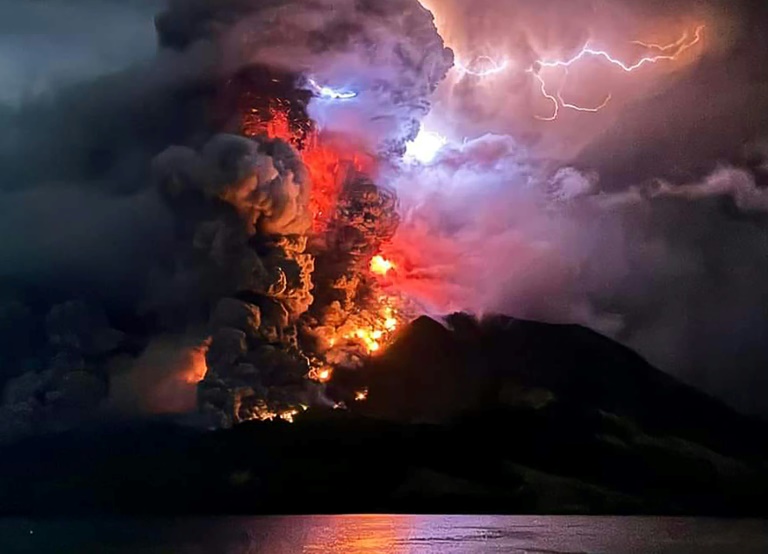Science
Scientists Uncover Trigger Behind Lightning Formation in Thunderclouds

Recent research has unveiled the mechanisms that initiate lightning within thunderclouds, offering significant insights into this natural phenomenon. This study represents the first quantitative, physics-based explanation for lightning initiation, shedding light on the complex dynamics occurring in Earth’s atmosphere.
The process begins with static charges accumulating within rain clouds. As turbulent winds circulate, water droplets are lifted to high altitudes, where they encounter freezing temperatures, transforming into ice particles. Concurrently, downdrafts within the cloud push ice and hail downwards. What triggers the actual discharge of lightning, however, has remained largely a mystery until now.
Scientists observed that spectacular bursts of X-rays and accompanying radio emissions are linked to lightning activity. According to Victor Pasko, professor of electrical engineering at Penn State University, “Our findings provide the first precise, quantitative explanation for how lightning initiates in nature. It connects the dots between X-rays, electric fields, and the physics of electron avalanches.”
The researchers employed mathematical modeling to explain field observations concerning photoelectric phenomena. These phenomena occur when relativistic energy electrons, influenced by cosmic rays from outer space, multiply within thunderstorm electric fields, leading to the emission of high-energy photon bursts. This occurrence is referred to as a terrestrial gamma-ray flash, or “dark lightning.”
These flashes can last from 0.2 to 3.5 milliseconds and can reach energies of up to 20 million electronvolts. It is suggested that the intense electric fields, either above or inside thunderstorms, are responsible for this remarkable phenomenon.
Pasko elaborated, “By simulating conditions with our model that replicated the conditions observed in the field, we offered a complete explanation for the X-rays and radio emissions present within thunderclouds.” He added that the accelerated electrons create an avalanche effect, leading to the generation of high-energy photons that trigger lightning.
The findings are documented in the Journal of Geophysical Research: Atmospheres, in an article titled “Photoelectric Effect in Air Explains Lightning Initiation and Terrestrial Gamma Ray Flashes.”
Record-Breaking Lightning Strikes
In a related development, a recent lightning bolt measuring 515 miles has been recorded, illuminating the skies from Texas to Kansas City. This exceptional phenomenon, classified as a “megaflash,” breaks previous records and enhances our understanding of extreme weather patterns.
These massive lightning discharges, which can span hundreds of miles, originate from long-lived, sprawling thunderstorms and pose significant risks even in seemingly clear conditions. Most lightning flashes typically extend less than 10 miles, but when a bolt exceeds 60 miles (approximately 100 kilometers), it is categorized as a megaflash. Remarkably, fewer than 1 percent of thunderstorms produce such extensive lightning.
The occurrence of a lightning bolt exceeding 500 miles is truly extraordinary, emphasizing the need for continued research into the mechanisms and consequences of lightning activity. As scientists delve deeper into the complexities of thunderstorm dynamics, the new findings regarding lightning initiation may lead to improved safety measures and forecasting techniques for severe weather events.
Through these advancements in understanding, researchers hope to enhance public awareness and preparedness for the dangers associated with lightning and extreme weather phenomena.
-

 Politics4 weeks ago
Politics4 weeks agoSecwepemc First Nation Seeks Aboriginal Title Over Kamloops Area
-

 World5 months ago
World5 months agoScientists Unearth Ancient Antarctic Ice to Unlock Climate Secrets
-

 Entertainment5 months ago
Entertainment5 months agoTrump and McCormick to Announce $70 Billion Energy Investments
-

 Science5 months ago
Science5 months agoFour Astronauts Return to Earth After International Space Station Mission
-

 Lifestyle5 months ago
Lifestyle5 months agoTransLink Launches Food Truck Program to Boost Revenue in Vancouver
-

 Technology3 months ago
Technology3 months agoApple Notes Enhances Functionality with Markdown Support in macOS 26
-

 Lifestyle3 months ago
Lifestyle3 months agoManitoba’s Burger Champion Shines Again Amid Dining Innovations
-

 Top Stories2 months ago
Top Stories2 months agoUrgent Update: Fatal Crash on Highway 99 Claims Life of Pitt Meadows Man
-

 Politics4 months ago
Politics4 months agoUkrainian Tennis Star Elina Svitolina Faces Death Threats Online
-

 Sports5 months ago
Sports5 months agoSearch Underway for Missing Hunter Amid Hokkaido Bear Emergency
-

 Politics5 months ago
Politics5 months agoCarney Engages First Nations Leaders at Development Law Summit
-

 Technology5 months ago
Technology5 months agoFrosthaven Launches Early Access on July 31, 2025











